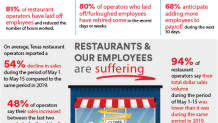Today, phase three of Gov. Greg Abbott's reopening plan for Texas continues.
Restaurants can now increase occupancy levels to 75%.
However, industry leaders say it's not enough to undo the economic damage.
“Restaurants know and we know that 25%, 50% and 75% -- that’s not a sustainable model. Just re-opening dining rooms is not enough for restaurants,” said Anna Tauzin, Chief Revenue and Innovation Officer for the Texas Restaurant Association. “We are still anticipating that 25% to 30% of restaurants will close permanently because of the effects of the pandemic.”
Those are bold words from Tauzin, an industry expert shared with NBC 5 some new data that paints a picture of what has been happening to businesses since the start of the pandemic.
Pre-pandemic, there were more than 50,000 restaurants in the state and 1.3 million people working in the food services industry, the second largest industry in the state.
The TRA conducted a poll with more than 500 restaurant operators across Texas, many from the Dallas, Houston, Austin and San Antonio areas. Operators were asked a series of questions after Memorial Day weekend and the results were released a few days ago.
Having trouble viewing the document above? Click here to open it in a new window.
Overall, 60% of operators say it's unlikely their restaurant will be profitable in the next 6 months.
“This is been really unprecedented time for restaurants. They have gone through things they never thought they had to - in terms of learning how to pivot your business on a dime, literally on a dime,” Tauzin said. “And Having to lay off hundreds and hundreds of people -- that’s also a blow. Not only to your bottom line but also to your soul.”

Even though the capacity limits are increased, Tauzin added that many places are finding it difficult to realistically achieve 75 percent. That's because CDC guidelines are still enforcing social distancing between tables and sometimes that's just not feasible in some smaller businesses.
Local
The latest news from around North Texas.
"Part of the 75 percent means we're able to also reduce the space between tables to four feet instead of six feet, if you have a barrier in place. If you don't have a barrier in place, you have to use that six-foot definition and that's really hard,” she said. “I've seen restaurants take out their grid paper and start moving tables around to figure out, how can I squeeze more people in to increase the capacity?"
Tauzin said for example, even bigger restaurants are barely able to reach 50 percent capacity with the tables spaced out properly.
Those who seem to be doing well are businesses with big patios. Those with booths are also finding it easier to bring in more diners.
“Restaurants that have a lot of booths are great because booths are back to back. You’re not looking at the person. And you have to put a barrier between the booths but a lot of them have that already,” said Tauzin.
The TRA said it is in contact with the governor’s office for the latest updates on reopening the economy. If the social distancing rules stay the same indefinitely, consumers might start seeing some measures being taken at businesses to bring more people in safely, such as plexiglass installed around tables.
Currently, phase three of the reopening plan also includes bars, which are able to operate at 50% capacity. That industry is struggling, too.
“Their model isn’t as flexible. Their business model is to get as many people in as possible and sell as many drinks as possible in the shortest amount of time as possible,” said Tauzin. “So for bars, they have to really think completely outside the box in order to stay open. I know a lot of them are doing the best they can.”
If another wave of COVID-19 cases gets out of control, experts predict there could be more shutdowns to curb the spread of the virus in the future.
“Unfortunately I’m sure you’ve seen images from over the weekend, there’s some places that are packed way beyond what they should be and I hope that they’re able to scale back because they’re making it really hard for a lot of other peers to do well,” said Tauzin.
There is some good news. The Better Business Bureau said consumer trends show people itching to get out and support local businesses.
“Consumers do you want to spend in restaurants, they do want to go out but it’s not as much as before,” said Tauzin. “We lost a lot of customers to grocery over the past three months and it’s going to just take a little while for them to come back.”



